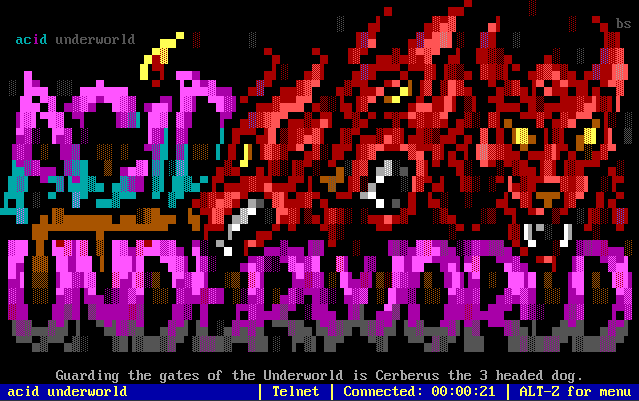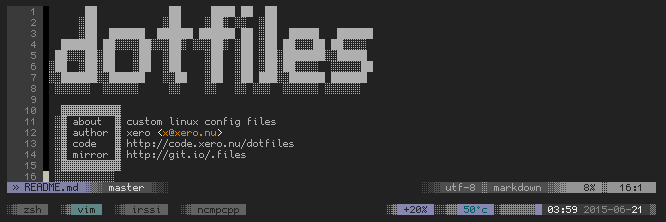legend of zelda ascii/ansi art
ascii :: as a member of blocktronics
my love of ansi/ascii art has been growing lately. i've joined up with the prolific group blocktronics aka 67. my first scene release is in artpack #16 "block n' roll".
my love of ansi/ascii art has been growing lately. i've joined up with the prolific group blocktronics aka 67. my first scene release is in artpack #16 "block n' roll".

i've been a long time fan of text mode art. i got my first glimpse into that world back in the nineteen hundred and nineties, with groups like ACiD and remorse. back in pre-modern internet days we had to dial up a BBS (bulletin board system) to chat or download files. over time, these systems became either mail/chat hubs or w4r3z distros. because of the questionable legality of some of these releases a login system was added to all BBS' (though many supported a "guest" login"). some had open registration while others were invite only.
this is my arch linux install guide. it's not meant to replace the beginners guide or the install guide, but act as a quick overview of exactly what the install process entails. hopefully this will encourage those intimidated by the terminal only install process.
this setup is for my HP Envy 6t-1000 laptop. it has a 32gb ssd drive with two partitions for boot and / and the other 500gb hdd is my home. my laptop has plenty of ram so i do not use a swap. my laptop also has UEFI bios and will cover it's install procedure.
boot to the install medium and you will be greeted by the prompt:
root@archiso ~ # in the unix world programs are commonly configured in two different ways, via shell arguments or text based configuration files. programs with many options like text editors are configured on a per-user basis with files in your home directory ~. in unix like operating systems any file or directory name that starts with a period or full stop character is considered hidden, and in a default view will not be displayed. thus the name dotfiles.
in the unix world programs are commonly configured in two different ways, via shell arguments or text based configuration files. programs with many options like text editors are configured on a per-user basis with files in your home directory ~. in unix like operating systems any file or directory name that starts with a period or full stop character is considered hidden, and in a default view will not be displayed. thus the name dotfiles.
it's been said of every console user:
you are your dotfiles
ok, i said that ;P
since they dictate how your system will look and function.
i manage mine with gnu stow, a free, portable, lightweight symlink farm manager. this allows me to keep a versioned directory of all my config files that are virtually linked into place via a single command....
atom is a "hackable text editor for the 21st century" created by the team at github. it's designed to be customizable, but also usable without needing to edit a config file.
because we spend most of our day in a text editor, the single most important feature we wanted in an editor was extensibility. atom is built with the same open source technologies used by modern web browsers. at the core of atom is chromium, the open source project behind google chrome. with that comes all the power and innovation being developed for the web. but more importantly, extending atom is as simple as writing javascript and css, two languages used by millions of developers each day.
atom.io

git is a distributed revision control and source code management (SCM) system with an emphasis on speed. git was designed by linus torvalds, of linux fame, for managing the development of the kernel. every git working directory is a fully fledged repository, complete with revision tracking abilities independent of a network or centralized server. git is 100% open-source, freeware, and distributed under the GNU general public license v2.

the Bioregenerative Life Support System Simulator, BLiSS Sim, is an ipad app, built with titanium studio, based on investigations conducted by NASA scientists and engineers to explore how plants can be grown to provide air, water, and food for astronauts at a lunar base.
BLiSS uses a game format to engage youth and adults in the challenges of supporting humans in space or extreme environments on earth.
The app is free and available for download from the iTunes Store.
Visit the promotional website at: http://bliss-sim.cet.edu/
